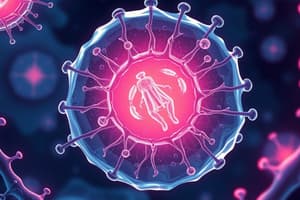Podcast
Questions and Answers
What is the primary function of villi in the small intestine?
What is the primary function of villi in the small intestine?
- To increase surface area for absorption (correct)
- To produce digestive enzymes
- To transport nutrients to the bloodstream
- To create a barrier against pathogens
Gene expression is a process that determines how cells differentiate and function.
Gene expression is a process that determines how cells differentiate and function.
True (A)
What allows villi to contract and expand?
What allows villi to contract and expand?
Muscle strand
Each villus contains a lacteal that absorbs __________ and glycerol.
Each villus contains a lacteal that absorbs __________ and glycerol.
Match the following cell types with their functions:
Match the following cell types with their functions:
What structure projects from the villi to increase surface area?
What structure projects from the villi to increase surface area?
Cell specialization results from not all genes being expressed during differentiation.
Cell specialization results from not all genes being expressed during differentiation.
What are the cells that work to keep the human body free of infections?
What are the cells that work to keep the human body free of infections?
What does cell differentiation refer to?
What does cell differentiation refer to?
Flagella are primarily used for locomotion in cells.
Flagella are primarily used for locomotion in cells.
What role does RNA play in cell function?
What role does RNA play in cell function?
Cilia in the kidney bend __________ as urine passes, sending signals to the cells.
Cilia in the kidney bend __________ as urine passes, sending signals to the cells.
Which of the following is NOT an example of a specialized cell?
Which of the following is NOT an example of a specialized cell?
All multicellular organisms begin as a multicellular structure.
All multicellular organisms begin as a multicellular structure.
In sponges and coelenterates, flagellar motion is important for __________.
In sponges and coelenterates, flagellar motion is important for __________.
Match the following structures with their respective adaptations or functions:
Match the following structures with their respective adaptations or functions:
Which of the following statements is true regarding cancer cells?
Which of the following statements is true regarding cancer cells?
Meristem cells are responsible for the differentiation into vascular, dermal, and ground tissues in plants.
Meristem cells are responsible for the differentiation into vascular, dermal, and ground tissues in plants.
What are the three classifications of meristems based on their location in a plant?
What are the three classifications of meristems based on their location in a plant?
Cancer can originate from mutations due to exposure to chemicals, radiation, and __________.
Cancer can originate from mutations due to exposure to chemicals, radiation, and __________.
Match the following cell types with their adaptations or functions:
Match the following cell types with their adaptations or functions:
Flashcards are hidden until you start studying
Study Notes
Cell Specialization and Differentiation
- Cell differentiation occurs after cell division, modifying newly formed cells to effectively perform specific functions.
- Special structures within cells aid in their specialized functions, such as antennas that receive and process sensory information.
- Cilia in the kidneys detect urine flow, signaling the cells about urinary movement.
Flagella
- Flagella are whip-like structures that serve as locomotion organelles in many organisms.
- The motion of flagella generates water currents essential for respiration and circulation in sponges and coelenterates.
- Most motile bacteria utilize flagella for movement.
Villi
- Villi are small finger-like projections in the small intestine that enhance surface area for nutrient absorption.
- Each villus contains muscle strands for contraction and lacteals for absorbing fatty acids and glycerol.
- Microvilli extend from villi, further increasing absorption area and featuring protein pumps for nutrient transport.
Leukocytes
- Leukocytes play a crucial role in defending the body against infections by targeting and eliminating microbes.
- They differentiate into three primary tissue types: vascular, dermal, and ground tissue.
Cancer Cells
- Cancer cells arise from abnormal properties leading to uncontrolled division and spreading within the body.
- Factors contributing to cancer development include exposure to chemicals, radiation, and genetic mutations.
- Cancer cells exhibit reduced sensitivity to growth inhibition signals and often evade programmed cell death (apoptosis).
Meristems in Plants
- Meristems are regions in plants capable of growth and division, classified as apical, lateral, and intercalary.
- Apical meristems are found at root and shoot tips, lateral meristems are located in vascular and cork cambia, and intercalary meristems occur between leaf attachments on stems.
Studying That Suits You
Use AI to generate personalized quizzes and flashcards to suit your learning preferences.




